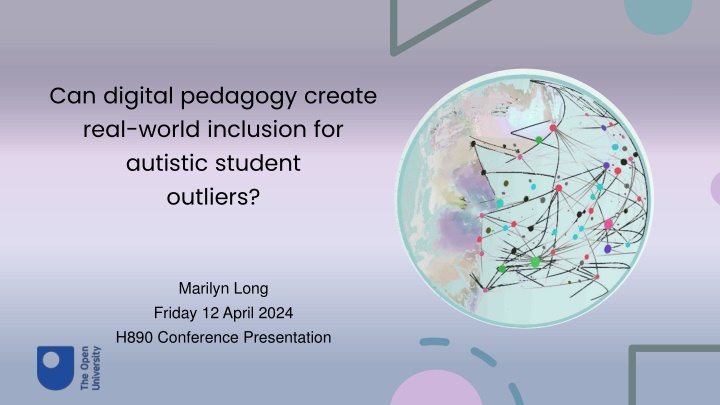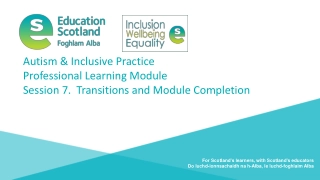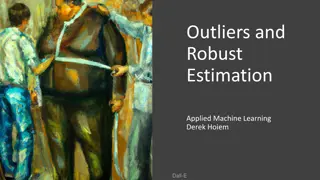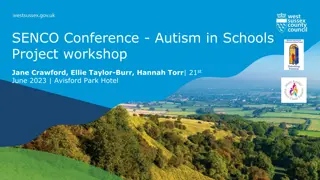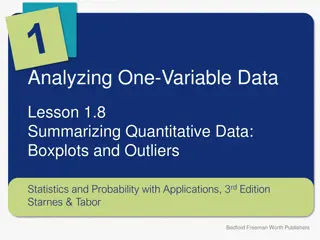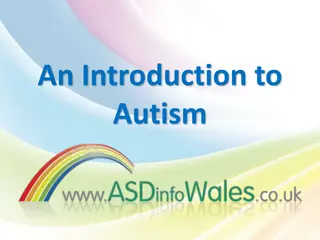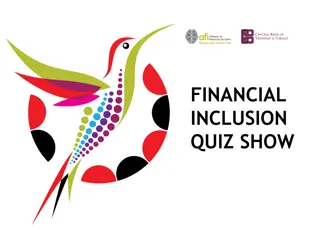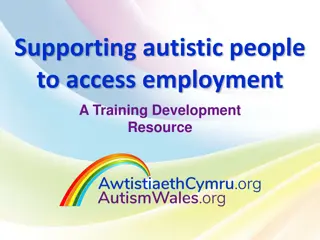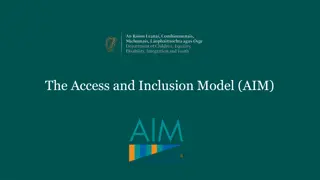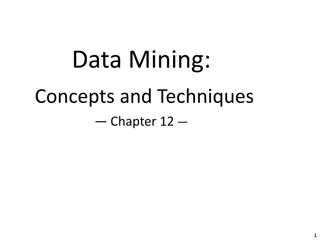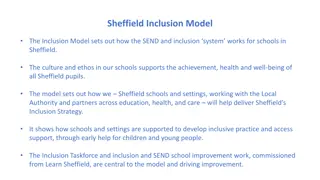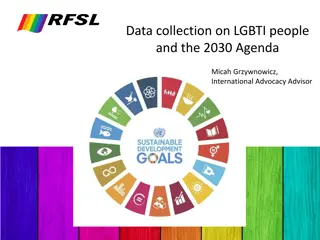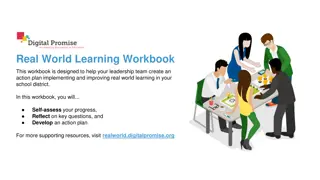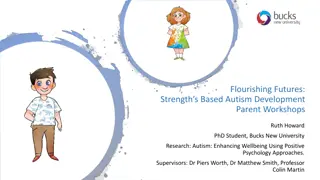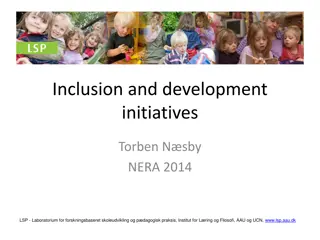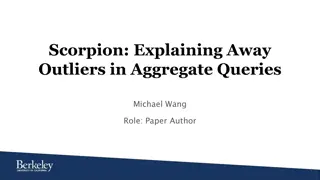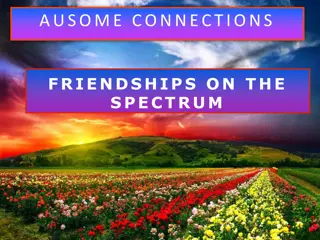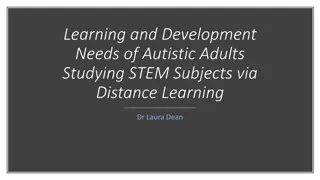Creating Real-World Inclusion for Autistic Student Outliers
Digital pedagogy can support autistic student outliers in higher education by addressing barriers, values, and expectations, promoting a sense of belonging, and embracing neurodiversity
Download Presentation

Please find below an Image/Link to download the presentation.
The content on the website is provided AS IS for your information and personal use only. It may not be sold, licensed, or shared on other websites without obtaining consent from the author.If you encounter any issues during the download, it is possible that the publisher has removed the file from their server.
You are allowed to download the files provided on this website for personal or commercial use, subject to the condition that they are used lawfully. All files are the property of their respective owners.
The content on the website is provided AS IS for your information and personal use only. It may not be sold, licensed, or shared on other websites without obtaining consent from the author.
E N D
Presentation Transcript
Can digital pedagogy create real-world inclusion for autistic student outliers? Marilyn Long Friday 12 April 2024 H890 Conference Presentation
How do autistic students become outliers within a higher education community? 2
Autistic student: more than the sum of its parts Being autistic A lifelong neurotype Not a difference, disorder, diversity An essential way of being and thinking Not a choice nor a lifestyle Significantly impacts everyday functioning Not a variable, ubiquitous condition Being an autistic student Affects organisation and self-management ability Affects ability to cope with changes to expected activity, schedule, or format Affects ability for reflection and to project mind to visualise future planning 3
Educator values and expectations for the ideal student Students are valued for being thorough, focused, and engaged organised and methodical supportive of others Students are expected to reflect on tasks and progress CC Microsoft 365 demonstrate academic skills have a confident outlook 4
The barrier of values and expectations The concept of the ideal student can reinforce preconceptions that can be unhelpful to students who do not (or perceive themselves not to) meet assumed expectations. (Koutsouris, Mountford-Zimdars & Dingwall, 2021) CC Microsoft 365 5
Hidden barriers and a sense of belonging issues with the hidden curriculum can have indirect effects on obtaining assistance for other particular needs, which can have a further negative impact on the learning experience of a student with ASD. (Byrne, 2022) the emotional stress of trying to conform to unknown expectations can lead many autistic students feeling like an outsider. (Cage, De Andres, and Mahoney, 2020) 6
talking-the-talk and walking-the-walk life on the inside of an academic community En-abled students: - understand the language and social norms; - enjoy complete access to physical spaces. Visibly dis-enabled students: - face barriers when accessing physical spaces. Invisibly dis-enabled students: - challenged by the language and social norms; - challenged by sensory and social stimuli of physical spaces. 8
Why is Real World inclusion in online higher education important? 9
Does higher education practice prepare students for real life? Students are expected to conform to a system that provided inadequate recognition or allowance for their difference. (Ellis, Kao, and Pittman, 2020) We should not be aiming to remediate autism, but working with autistic ways of being in an inclusive future of education (Milton, 2018) CC Microsoft 365 10
Changing focus or practice? Changing focus? rethink the key players rethink inclusion priorities rethink legal and ethical responsibilities Changing practice? challenge bias at every level design for divergent inclusions and narratives engage in open dialogue not just to direct, but to learn 11
Can online education create inclusion? Or just the illusion? The benefits of online learning The challenges of online learning Who is responsible for organising reasonable adjustments? How does the future for inclusion look from the outside? 12
Diolch, pawb Thank you, everyone marilyn.long@open.ac.uk
Can digital pedagogy create real-world inclusion for autistic student outliers? Presentation references are listed under each theme on Slides 15 -18. References to my own writings, available on the OU site, are listed on Slide 19. For a transcript of my presentation and a list of references, please contact me at: marilyn.long@open.ac.uk
references Slide 3: The autistic student; autistic masking Pearson, A. and Rose, K. (2021) A Conceptual Analysis of Autistic Masking: Understanding the Narrative of Stigma and the Illusion of Choice , Autism in Adulthood, 3(1), pp. 52 60. Available at: https://doi.org/10.1089/aut.2020.0043. Slide 4: The ideal student Ellis, K., Kao, K.-T. and Pittman, T. (2020) The Pandemic Preferred User , Fast Capitalism, 17(2), pp. 17 27. Available at: https://doi.org/10.32855/fcapital.202002.002. Wong, B. and Chiu, Y.-L.T. (2021) Exploring the concept of ideal university student , Studies in Higher Education, 46(3), pp. 497 508. Available at: https://doi.org/10.1080/03075079.2019.1643302. Wong, B., DeWitt, J. and Chiu, Y.-L.T. (2023) Mapping the eight dimensions of the ideal student in higher education , Educational Review, 75(2), pp. 153 171. Available at: https://doi.org/10.1080/00131911.2021.1909538 . Slide 5: Barriers of values and expectations Koutsouris, G., Mountford-Zimdars, A. and Dingwall, K. (2021) The ideal higher education student: understanding the hidden curriculum to enable institutional change , Research in Post-Compulsory Education, 26(2), pp. 131 147. Available at: https://doi.org/10.1080/13596748.2021.1909921. 15
references Slide 6: The hidden curriculum and outliers Bullough, R.V. (2012) Against best practice: uncertainty, outliers and local studies in educational research , Journal of Education for Teaching, 38(3), pp. 343 357. Available at: https://doi.org/10.1080/02607476.2012.668335. Byrne, J.P. (2022) Perceiving the social unknown: How the hidden curriculum affects the learning of autistic students in higher education , Innovations in Education and Teaching International, 59(2), pp. 142 149. Available at: https://doi.org/10.1080/14703297.2020.1850320. Cage, E., De Andres, M. and Mahoney, P. (2020) Understanding the factors that affect university completion for autistic people , Research in Autism Spectrum Disorders, 72, p. 101519. Available at: https://doi.org/10.1016/j.rasd.2020.101519. Chalabi, M (n.d.) What we miss when we focus on the average . TED Audio Collective. Available at: https://www.ted.com/talks/mona_chalabi_what_we_miss_when_we_focus_on_the_average/transcript?language =en 16
references Slide 7: Autistic students and belonging Milton, D., Martin, N. and Melham, P., (2017). Beyond reasonable adjustment: autistic-friendly spaces and Universal Design. Autism and Intellectual Disability in Adults Volume 1. Pavilion Publishing and Media. Available at: https://pavpub.com/health-and-social-care/health-learning-disability/autism-and-intellectual-disability-in-adults-volume-1 . Milton, D. and Sims, T. (2016) How is a sense of well-being and belonging constructed in the accounts of autistic adults? , Disability & Society, 31(4), pp. 520 534. Available at: https://doi.org/10.1080/09687599.2016.1186529. Williams, Gemma (2023) Autistic people experience loneliness far more acutely than neurotypical people new research , The Conversation [Preprint]. Available at: https://theconversation.com/autistic-people-experience-loneliness- far-more-acutely-than-neurotypical-people-new-research-216471. Slide 8: Life on the inside of an academic community Pesonen, H.V., Nieminen, J.H., Vincent, J., Waltz, M., Lahdelma, M., Syurina, E.V. and Fabri, M. (2020) A socio-political approach on autistic students sense of belonging in higher education , Teaching in Higher Education, pp. 1 19. Available at: https://doi.org/10.1080/13562517.2020.1852205. Slide 9: Real World inclusion Open University (2019) Glossary of terms on Accessibility . 17
references Slide 10: Higher education practice that prepares students for real life Byrne, J.P. (2022) Perceiving the social unknown: How the hidden curriculum affects the learning of autistic students in higher education , Innovations in Education and Teaching International, 59(2), pp. 142 149. Available at: https://doi.org/10.1080/14703297.2020.1850320 . Cage, E. and Howes, J. (2020) Dropping out and moving on: A qualitative study of autistic people s experiences of university , Autism, 24(7), pp. 1664 1675. Available at: https://doi.org/10.1177/1362361320918750. Ellis, K., Kao, K.-T. and Pittman, T. (2020) The Pandemic Preferred User , Fast Capitalism, 17(2), pp. 17 27. Available at: https://doi.org/10.32855/fcapital.202002.002. Milton, D (2018) Autism and the Future of Education, WISE. Available at: https://www.wise-qatar.org/autism-future- education-damian-milton-muhammad-salman-bin-mohamed-khair/ (Accessed: 25 March 2024). Slide 11, Changing focus or practice Lister, K., Pearson, V.K., Collins, T.D. and Davies, G.J. (2020) Evaluating inclusion in distance learning: a survey of university staff attitudes, practices and training needs , Innovation: The European Journal of Social Science Research [Preprint]. Available at: https://www.tandfonline.com/doi/full/10.1080/13511610.2020.1828048 (Accessed: 3 April 2023). Von Below, R., Spaeth, E. and Horlin, C. (2021) Autism in Higher Education: dissonance between educators perceived knowledge and reported teaching behaviour , International Journal of Inclusive Education, pp. 1 18. Available at: https://doi.org/10.1080/13603116.2021.1988159. 18
references Long, M (2021). Empowering autistic students to thrive in higher education: an investigation into stakeholder participation in redefining the barriers to inclusivity and improve the relevance of accessibility policy and procedures. Student dissertation for The Open University module YXM830 Advance your independent learning. Available at: DOI: https://doi.org/10.21954/ou.ro.000162f3 Long, M (2023) Autism beneath the surface: Reframing the autistic student experience of higher education. Available at: Autism beneath the surface PP (1).pptx (sharepoint.com) Long, M and Coughlin, T (2023) Designing learning for autistic students Available at: Designing-learning-for-autistic- students-revised-version-2023.pdf (sharepoint.com) National Autistic Society, (n.d.) Advice and guidance on professional practice. Available at: https://www.autism.org.uk/advice-and-guidance/professional-practice/tips-students-university 19
